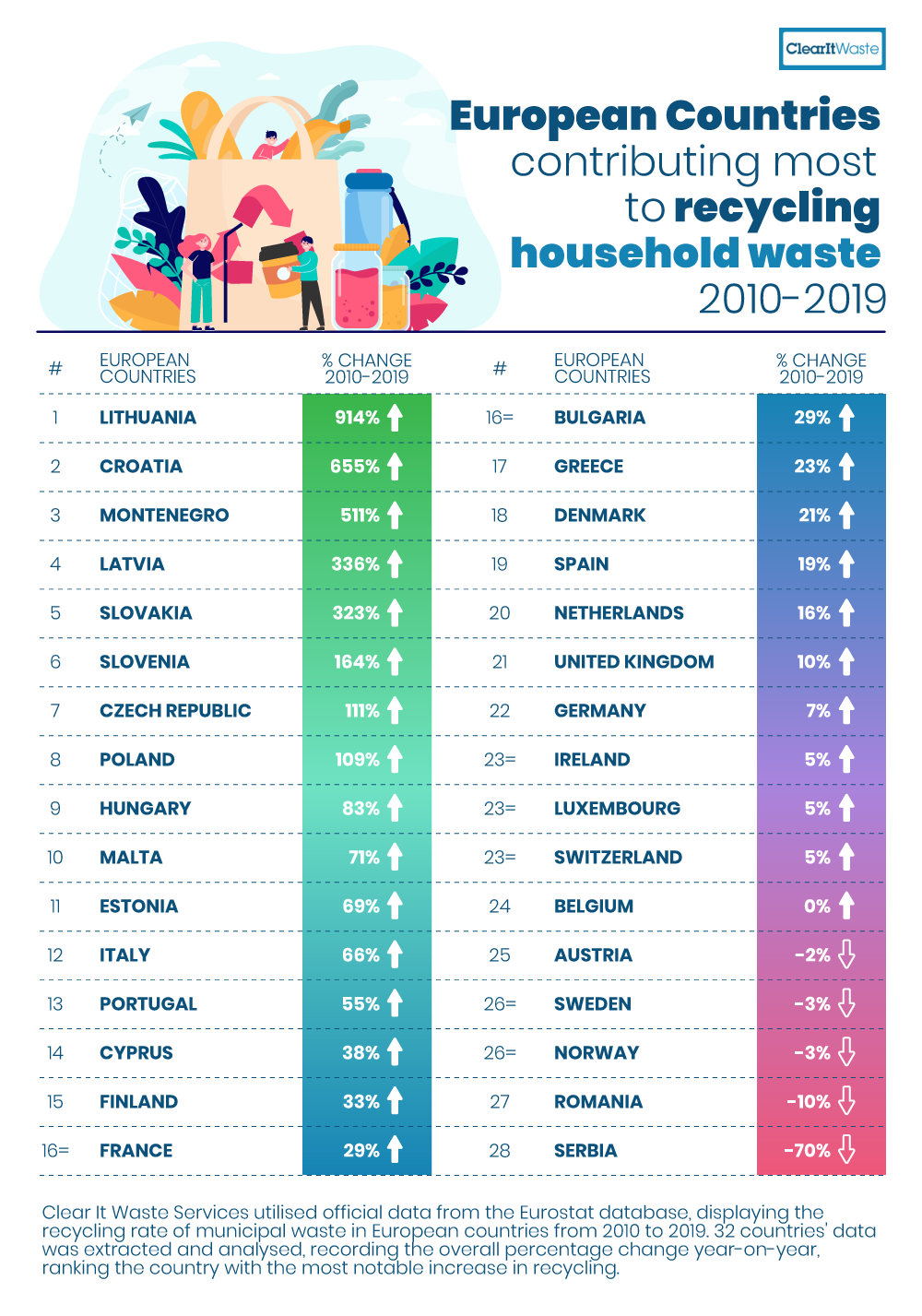Which European Countries Recycle the Most?
The European Environment Agency (EEA) has seen a significant increase in household waste in Europe in recent years, as their aim of making Europe climate neutral by 2050 heightens. With this in mind, we were keen to investigate which European countries have improved most when it comes to recycling household waste since 2010.
To achieve this, we utilised official data from Eurostat, displaying the recycling rate of municipal waste per European country from 2010 to 2019. 32 countries’ data was extracted and analysed, recording the overall percentage change year-on-year, ranking the country with the most notable increase in recycling over the last decade.
Which European countries recycled the most household waste between 2010 and 2019?
The podium goes to Lithuania which, since 2010, has seen the recycling of household waste grow by 914%, going from a pitiful 5% in 2010 to a recycling rate of 49.7% documented in 2019. This equates to almost five times the amount, which gives an overall average rate of 33.8% in the studied years.
Croatia follows behind in second place in terms of the increase in household waste recycling among the 32 observed countries, as the household waste recycling in Croatia increased by 655% between 2010 and 2019. According to our analysis, the recycling rate in 2019 was 30.2%, compared to only 4% in 2010.
Another Balkan country, Montenegro, is in third place with an increase in household waste recycling by 511% from 2010 to 2019. However, despite the country’s efforts and the improvement in recycling over the years, the country’s overall recycling rate between 2010 and 2019 reached an average of just 3.6%, placing second to last for countries with the most notable average change.
With a percentage change of 336% overall between 2010 and 2019, Latvia comes in fourth place. Our research found that the northwestern European country – nestled between three Baltic states – recorded a recycling rate of just 9.4% in 2010. However, the most recent data (2019) sees this figure jump up to more than four times this to 41%.
Rounding off the top five is Slovakia. The central European nation recorded a recycling rate of 9.1% in household waste in 2010, which increased to 38.5% in 2019, recording an overall increase of 323%. That’s just 13% more than Latvia in fourth.
Among other countries studied, Slovenia grew by 164%, ranking in sixth place, while Bulgaria shares 16th position with France, with an increase of 29%, and Greece ranks 17th, with 23%.
The countries with the lowest change in household recycling rates, 2010-2019
| RANKING | EUROPEAN COUNTRIES | % CHANGE IN RECYCLING RATE 2010-2019 |
| 28 | SERBIA | -70% |
| 27 | ROMANIA | -10% |
| 26= | NORWAY | -3% |
| 26= | SWEDEN | -3% |
| 25 | AUSTRIA | -2% |
| 24 | BELGIUM | 0% |
Serbia recorded the largest decline in household waste recycling in Europe between 2010 and 2019 and with the worst recycling rate with a decrease of -70%. The country has the lowest average recycling rate at 0.4% out of all the European countries studied.
The second largest drop in recycling (10%) was recorded in Romania
With no increase from 2010, Belgium has shown no notable improvements when it comes to its household recycling rates. But, despite no year-on-year improvement, Belgium places third overall for the highest average recycling rate.
Countries with the highest average recycling rate in household waste
| RANKING | EUROPEAN COUNTRIES | AVERAGE RECYCLING RATE 2010-2019 |
| 1 | GERMANY | 65.5% |
| 2 | AUSTRIA | 57.6% |
| 3 | BELGIUM | 53.9% |
| 4 | NETHERLANDS | 52.1% |
| 5 | SWITZERLAND | 51.8% |
The highest average recycling rate in Europe was recorded in Germany, where 65.5% of household waste is recycled and reused. According to our research, Austria came in second with a rate of 57.6%, followed by Belgium, with 53.9%, the Netherlands, with 52.1%, and Switzerland, with 51.8%.
Countries with the lowest average recycling rate in household waste
| RANKING | EUROPEAN COUNTRIES | AVERAGE RECYCLING RATE 2010-2019 |
| 32 | SERBIA | 0.4% |
| 31 | MONTENEGRO | 3.6% |
| 30 | MALTA | 9.3% |
| 29 | ROMANIA | 12.9% |
| 28 | GREECE | 14.4% |
The lowest average household recycling rate in Europe was recorded in Serbia, where just 0.4% of household waste is recycled – 65.1% less than Germany with the most. Montenegro followed in second with an average recycling rate of 3.6%, Malta in third (9.3%), Romania in fourth (12.9%) and Greece in fifth (14.4%).
Methodology:
- Clear It Waste utilised the Eurostat database on European countries’ recycling rate of municipal waste.
- Raw data of official household recycling rates were accumulated from the year 2010 – 2019 for a 10-year analysis, with 2019 being the most recent year. Countries with no available data or a reported 0.00% for five years or more between the years researched were excluded from the study. Any data listed by Eurostat with an indication of an estimate, break in time series, definition difference etc., were noted.
- Once the data was collated, the percentage change of the recycling rate of municipal waste for each EU country was calculated. However, if the data was unavailable for the starting/and or most recent year analysed, the most recent data year available was calculated instead. The average recycling rate of municipal waste from 2010-2019 was also calculated for additional figures.
- Each country was ranked according to the percentage change, and any European countries with the most notable percentage increase in household recycling rate were ranked favourably.
- Data was collected on 02/07/2021 and is subject to change.
Please see the full data set here for more information.

